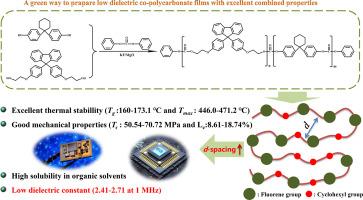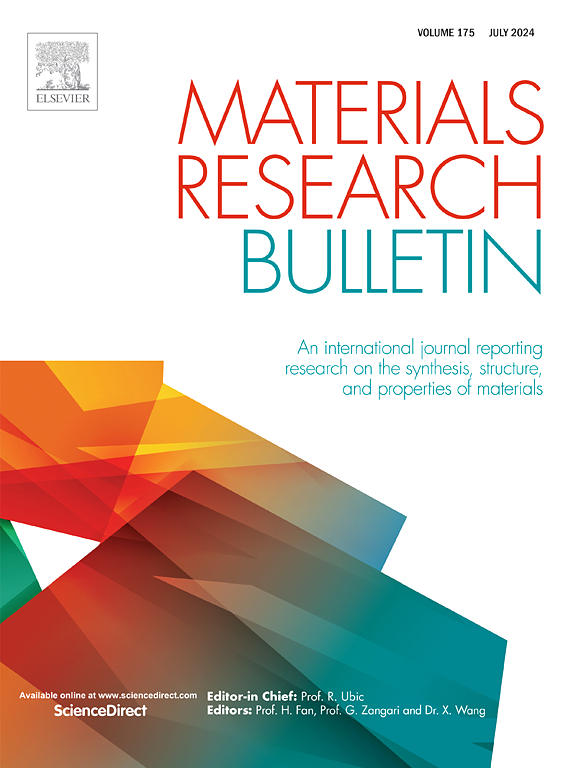具有环己基和芴结构的共聚碳酸酯的结构设计和合成:低介电常数、高溶解性和优异的机械性能
IF 5.7
3区 材料科学
Q2 MATERIALS SCIENCE, MULTIDISCIPLINARY
引用次数: 0
摘要
高速通信和大规模集成电路的快速发展加速了对低介电常数、低介电损耗和良好机械性能的绝缘介电材料的研究。本研究通过熔融酯交换反应合成了一系列含有环己基和芴结构的聚碳酸酯树脂,具有低介电常数、高耐热性和可溶性等特点。系统研究了芴结构含量对共聚碳酸酯树脂性能的影响。结果表明,非极性芴基团可降低共聚碳酸酯的分子极化,从而使共聚碳酸酯的介电常数较低,为 2.41-2.71@1 MHz。此外,该树脂还具有良好的溶解性,可在室温下溶解于 NMP、CH2Cl2、THF 等溶剂中。此外,共聚碳酸酯树脂还具有优异的耐热性(玻璃化转变温度(Tg)为 160.6-173.1 °C)和机械性能(拉伸强度为 50.54-70.72 兆帕)。这使其成为高速通信和大规模集成电路的理想候选材料。本文章由计算机程序翻译,如有差异,请以英文原文为准。

Structural designs and synthesis of co-polycarbonates with cyclohexyl and fluorene structures: Low-dielectric constant, high solubility, and superior mechanical properties
The rapid developments of high-speed communication and large-scale integrated circuits have accelerated the research for insulating dielectric materials with low dielectric constant, low dielectric loss, and good mechanical properties. In this study, a series of polycarbonate resins containing cyclohexyl and fluorene structures are synthesized by melt transesterification, which is low dielectric, highly thermally resistant, and soluble. The effects of fluorene structure contents on the properties of a co-polycarbonate resin were studied systematically. The results showed that the non-polar fluorene group could reduce the molecular polarization of co-polycarbonate, resulting in low permittivity of co-polycarbonate are 2.41–2.71@1 MHz. In addition, the resin has excellent solubility and can be dissolved in NMP, CH2Cl2, THF, and other solvents at room temperature. Furthermore, the co-polycarbonate resins also exhibit superior heat resistance with glass transition temperature (Tg) of 160.6–173.1 °C as well as admirable mechanical properties with a tensile strength of 50.54–70.72 MPa. This makes it a promising candidate for high-speed communications and large-scale integrated circuits.
求助全文
通过发布文献求助,成功后即可免费获取论文全文。
去求助
来源期刊

Materials Research Bulletin
工程技术-材料科学:综合
CiteScore
9.80
自引率
5.60%
发文量
372
审稿时长
42 days
期刊介绍:
Materials Research Bulletin is an international journal reporting high-impact research on processing-structure-property relationships in functional materials and nanomaterials with interesting electronic, magnetic, optical, thermal, mechanical or catalytic properties. Papers purely on thermodynamics or theoretical calculations (e.g., density functional theory) do not fall within the scope of the journal unless they also demonstrate a clear link to physical properties. Topics covered include functional materials (e.g., dielectrics, pyroelectrics, piezoelectrics, ferroelectrics, relaxors, thermoelectrics, etc.); electrochemistry and solid-state ionics (e.g., photovoltaics, batteries, sensors, and fuel cells); nanomaterials, graphene, and nanocomposites; luminescence and photocatalysis; crystal-structure and defect-structure analysis; novel electronics; non-crystalline solids; flexible electronics; protein-material interactions; and polymeric ion-exchange membranes.
 求助内容:
求助内容: 应助结果提醒方式:
应助结果提醒方式:


